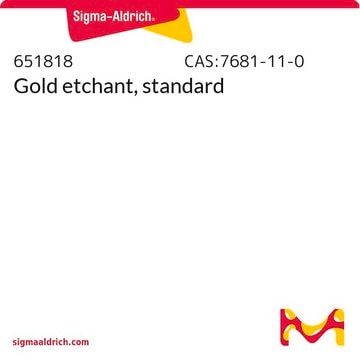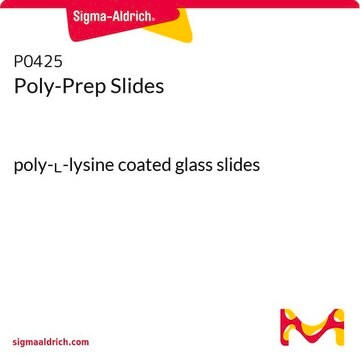643246
Gold coated glass slide
99.999% (Au), layer thickness 1000 Å
About This Item
Prodotti consigliati
Saggio
99.9% (Ti)
99.999% (Au)
Lungh. × largh. × spess.
3 in. × 1 in. × 0.7 mm
Spessore strato
1000 Å
Trasmittanza
380-700, >91% (for the glass microscope slide alone)
Indice di rifrazione
n20/400 1.52 (lit.)
Gruppi immobilizzati alla matrice
Titanium, as adhesion layer used to bind the gold to the aluminosilicate glass cover slip
Stringa SMILE
[Au]
InChI
1S/Au
PCHJSUWPFVWCPO-UHFFFAOYSA-N
Cerchi prodotti simili? Visita Guida al confronto tra prodotti
Categorie correlate
Applicazioni
- Simple surface modification of poly(dimethylsiloxane) for DNA hybridization.: Highlights the application of gold-coated glass slides in creating effective biosensors for DNA hybridization, supporting innovations in genomics and pharmaceutical research (Zhou et al., 2010).
- Multimodal spectroscopy combining time-of-flight-secondary ion mass spectrometry, synchrotron-FT-IR, and synchrotron-UV microspectroscopies on the same tissue section.: Utilizes gold-coated glass slides to integrate multiple spectroscopic techniques, enhancing the analysis of complex biological samples, pivotal for cutting-edge research in biochemistry and material sciences (Petit et al., 2010).
Caratteristiche e vantaggi
Altre note
Codice della classe di stoccaggio
11 - Combustible Solids
Classe di pericolosità dell'acqua (WGK)
nwg
Punto d’infiammabilità (°F)
Not applicable
Punto d’infiammabilità (°C)
Not applicable
Certificati d'analisi (COA)
Cerca il Certificati d'analisi (COA) digitando il numero di lotto/batch corrispondente. I numeri di lotto o di batch sono stampati sull'etichetta dei prodotti dopo la parola ‘Lotto’ o ‘Batch’.
Possiedi già questo prodotto?
I documenti relativi ai prodotti acquistati recentemente sono disponibili nell’Archivio dei documenti.
I clienti hanno visto anche
Articoli
Hybrid organic-inorganic sol-gel materials containing silica were first called “ORMOSILs” in 1984.
Protocolli
SAMs are versatile surface coatings for chemical resistance, bio-compatibility, sensitization, and molecular recognition for sensors and nano fabrication.
Il team dei nostri ricercatori vanta grande esperienza in tutte le aree della ricerca quali Life Science, scienza dei materiali, sintesi chimica, cromatografia, discipline analitiche, ecc..
Contatta l'Assistenza Tecnica.







